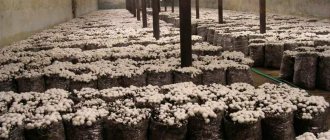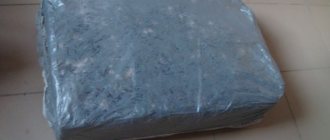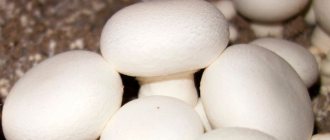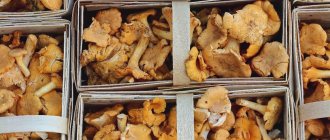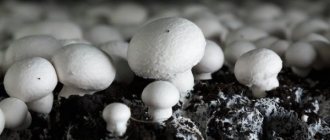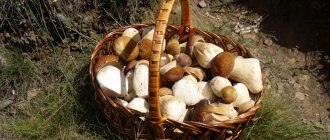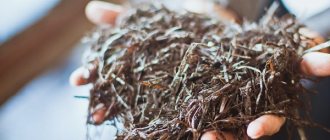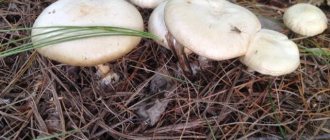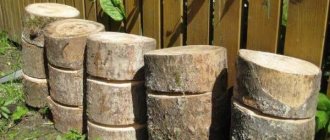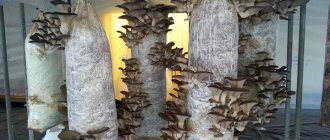What is needed for champignons
In nature, champignons can grow almost anywhere, preferring open, moist places with sufficiently nutritious soil.
Cultivation at home requires compliance with rather strict requirements:
- air humidity must be at least 60%;
- air temperature when planting mycelium is 24 - 27 degrees, when forcing fruiting bodies 15 - 17 degrees;
- soil nutrition should be high;
- constant ventilation of the room without drafts is required;
- Mushrooms do not require lighting; they grow better in the dark.
For year-round cultivation of champignons, rooms without sudden temperature changes - a cellar, basement or pantry - are well suited.
Substrate for growing champignons
The soil for cultivating mushrooms must be carefully prepared. Experienced experts recommend growing champignons by placing soil in bags or containers. If possible, use different rooms for planting mycelium or fungal spores and growing the fruiting body, rearranging bags or containers.
To prepare the substrate, use manure (preferably horse) and straw. For a plot of 1 sq. m need to take:
- 40 kg of straw;
- 20 kg of manure (horse or mullein);
- 800 g each of superphosphate and ammonium sulfate;
- 2.8 kg urea;
- 2 kg chalk.
It is necessary to soak the straw in warm water for one day. Then, in a suitable container, lay straw and manure in layers (about 6 layers), pouring warm water over each layer. After three days, mix, adding part of the urea, superphosphate and ammonium sulfate.
Planting and growing champignons
For sowing, mycelium grown on organic residues or cereal mycelium is used, in which oat, wheat or rye grain is a substrate for fungal spores.
Growing champignons (Photo from gluckspilze.com)
Planting technology differs among these species. The grains are scattered over the surface of the substrate, then sprinkled with soil. Mycelium grown on organic matter should be placed in holes (3 - 5 cm) at a distance of 15 - 20 cm from each other. The soil temperature should be no higher than 28°C, the room temperature should not be lower than 27°C, and air humidity should reach 90%.
Mushroom threads form on the surface after 2 weeks. They are sprinkled with a mixture of 5 parts peat, 1 part limestone and 4 parts earth. After 3 - 5 days, you should reduce the room temperature to 15 - 17 degrees, maintain air humidity at least 60% and ventilate, avoiding drafts.
After 3 months, mushrooms appear and grow within 1 – 2 weeks.
Growing champignons in the country
At the dacha or personal plot, champignons can be grown in a greenhouse or simply in a garden bed.
Greenhouses for champignons can be made of polycarbonate, glass or film, or greenhouses can be used. Since mushrooms do not tolerate direct sunlight, it is necessary to arrange shading. For ventilation, you can use household fans, installing them under the ceiling of the greenhouse to prevent drafts.
The bed is made 1.5 m wide by digging up the soil along with horse or cow manure added to it. Arcs are installed over the bed and covered with film. When the zucchini seedlings in the garden begin to grow, mushroom mycelium is planted between the bushes.
Growing champignons is a complex but fascinating process. With proper technology, enough time, concentration and care, you can grow mushrooms throughout the year.
Harvest time
The time for collecting mushrooms depends on the purpose for which the champignons are grown:
- for the commercial market they are collected young, with caps that have not yet opened;
- for home use - when the cap is open and flattened, and the lower frill begins to come off the stem, since at this stage they are more fragrant.
When harvesting, it is better to twist them from the root rather than cut them, which ensures new growth every 10 days. This can be done by grasping the mushroom, applying gentle pressure and twisting it. Do not pull the mushroom so as not to damage the mycelium. Pulled mushrooms retain freshness longer. And if mushrooms are grown for sale, then the stems add weight and thereby increase income. In collection baskets, mushrooms are placed with their stems down to avoid contamination of the cap plates.
You might be interested to know how and for how long you can store fresh champignons.
Cutting off the fungus can lead to rotting of the remaining root and infection of new formations of fruiting bodies and mycelium next to it. For this reason, it is important to clean out the remaining parts of the stems where the mushrooms had to be cut off, and then fill the empty spaces with substrate.
You can harvest around 5-10kg of mushrooms from 1m² of compost, depending on what stage they are collected at. The more often they are collected, the more champignons grow. Champignon grown in the garden is identical in aroma, taste and nutritional properties to mushrooms growing in the natural environment.
General conditions for fungal growth
If you have no experience at all in this matter, then first you need to consider the conditions for growing mushrooms. You can grow them in your own cellar or basement, since mushrooms do not require heat. If there is no such room, then it is best to carry out the procedure in a barn or greenhouse. One of the conditions is the presence of concrete walls and floors, as well as ventilation. To avoid pest attacks, cover all exits with a mosquito net. You also need to disinfect the walls and floor with lime.
In general, to start growing mushrooms in the cellar, you must achieve the following conditions:
- Temperature from +8°С to +20°С.
- Humidity 80%.
- Ventilation.
- Free from mold and pests.
- Purity.
Did you know? Based on the DNA of mushrooms, they are male and female.
Choosing the type of mushroom to grow
For beginners, the best option for growing would be oyster mushrooms; champignons are also suitable for small production. Most experienced mushroom growers prefer to grow exotic mushrooms, which you definitely won’t find in stores. Porcini mushrooms, chanterelles, honey mushrooms and boletus are well suited for growing mushrooms in summer cottages. Growing mushrooms at home is a profitable business, because such products are in demand among the population.
Growing champignons, varieties
Like any other mushrooms, champignons can be grown at home, in a summer cottage, in a basement, in a garage, or even in a greenhouse. Some gardeners even manage to engage in mushroom farming outdoors, risking being left without a fertile harvest. You can find out about each of the popular methods below.
From scratch in the basement in bags
Many mushroom growers, even those with extensive experience in germinating champignons, use the option of growing mushrooms in basements. A closed room is in most cases heated and does not need additional modification. All that remains is to install the humidifier and build a rack.
It is best to grow champignons in plastic bags. This method is the most practical for moving from one place to another.
The peculiarity of this method and its disadvantage is that during the process of mushroom appearance, the bags are transferred to a well-ventilated place. The change of location is extended for several weeks until the mushrooms are collected. Afterwards, the bag with the substrate is returned to its original place to begin the sequential process from scratch again.
In the garden
To start growing in beds, it is worth preparing the soil in the autumn. To do this, you should collect the top part of the soil from 15 to 35 cm, cover the bare area with a small layer of expanded clay, and cover it with sawdust or mowed grass.
At the end of spring, the soil should be cultivated, small holes made and infected with mycelium. If the mycelium is grain, it is scattered and compacted to retain more moisture.
Fruiting begins when the temperature reaches 23-27 degrees. Mushrooms have time to grow in 10-14 days.
On the balcony
Growing on a balcony is no different from the basement method. The only difference is the additional insulation of the room. The balcony should be glazed by insulating the brick walls using glass wool or ursa material.
In addition, there should be ventilation and convenient shelving.
Other growing methods include block and container methods. They allow you to grow champignons in a greenhouse and even a barn.
List of diseases and pests:
- mummies;
- mushroom mite;
- rotting;
- mushroom midge;
- mold (any type).
- When a mummy appears, the mycelium is removed along with the substrate.
- At the first sign of a mushroom mite, the mushrooms are sprayed with a metaphos solution.
- You can always get rid of fungus midges using chlorophos.
- Formalin will help against rot and mold.
How to plant champignons in the country
In areas with a short summer period and long winters, it is possible to grow mushrooms in the country only in greenhouses or basements. They grow well in open beds and only have time to ripen in a temperate climate. Let's learn how to grow champignons in the garden or vegetable garden.
How to prepare planting material
The mushroom harvest is obtained from mycelium, sold in specialized stores or farms that grow these mushrooms. Another option is to get it for free from natural myceliums, proceeding as follows.
- Remove a two-centimeter layer of soil near the mushrooms.
- We take square pieces of soil with mycelium threads measuring 10-20 cm.
- We put the loot in the container without stacking the squares on top of each other.
- Store until planting in a dry place with a temperature of 6-7 degrees Celsius.
Natural planting material is only suitable for growing without shelter: if you are interested in how to grow champignons in a garden in a greenhouse, you will need purchased mycelium - collected mycelium yourself will give a poor harvest.
To grow champignons on one square meter you will need 0.4 kg of mycelium.
How to plant champignons in the country
How to prepare a place for planting mushrooms
Champignons grow well in shaded, dry places, protected from icy winds. If your area is completely flooded with sun, we create artificial shade using a canopy.
Preparing soil for mushrooms in the fall
Before growing champignons in the garden, we form ridges, burying them below ground level, since mushrooms need moist coolness.
- To deepen them, we dig ditches with the following parameters: width 40 cm, height 30 cm, distance between ridges - 50 cm. The length depends on the volume of mycelium prepared for planting.
- We place drainage in the form of broken shards or bricks, crushed stone, etc. at the bottom of the ditches.
- We fill the trenches with green grass and fill them with cow dung.
- Cover everything with upside down turf.
We leave the ditches alone and return to them only in the spring.
Preparation of slurry
- We take half a barrel of manure.
- Sprinkle the manure directly in the barrel with wood ash and fill it with water.
- Infuse the mixture, stirring regularly, for ten days.
- Leave for another three days without stirring again.
In order not to inhale the manure “aromas” that the slurry will begin to emit after fermentation begins, we bury the barrel in the ground or place it away from the house.
How to prepare compost for planting
Growing champignons in the countryside is not complete without specially prepared compost made from:
- 100 kg of dry straw;
- 100 kg of horse, cow or other manure;
- 3.5 kg of ammonium nitrate;
- 8.5 kg of gypsum;
- 2 kg of superphosphate.
We prepare these components and proceed to the formation of compost for champignons.
How to prepare compost for planting
Preparation of champignon compost is as follows:
- Soak the straw raw material in water or wet it with a hose several times over 2 days.
- We divide the straw and manure into four piles and place them in layers in a bed (straw first). Add ammonium nitrate to each straw layer - 600 grams. The ridge should be 1-1.5 m wide, 1.2-1.5 m long and 1-1.5 m high.
Mix the compost heap four times - after 6, 5, 4 and another 4 days, using a pitchfork. The first time when mixing, add a quarter of the gypsum and moisten the pile with water, the second time we water it and add the remaining gypsum plus a third of superphosphate, the third and fourth times we proceed as during the second mixing.
Thanks to this interruption, carried out before growing champignons in the garden, the heap will be enriched with the necessary nutrients and oxygen.
How to plant champignon mycelium
Before growing champignons in open ground, remove a 25 cm layer of soil and disinfect it using a carbation solution. Then we make beds of compost in the form of ridges (height 30 cm, width at the bottom - 0.5 m).
We plant the mycelium as follows:
- We use a stick to make holes five centimeters deep and lay out the mycelium so that they are a couple of centimeters below the ground level - deeper. It is better to plant them in a checkerboard pattern, maintaining a distance of 15 cm between them.
- Cover the planted mycelium with compost and tamp it a little.
After five days, carefully lift the soil and check the mycelium for germination: they should begin to germinate. After 14-21 days, the entire compost will be covered with white sprouts.
How to properly prepare the substrate for champignons?
One of the key factors in obtaining a rich harvest of champignons is a properly selected substrate. Mushrooms are saprophytes, organisms that develop by extracting energy from organic matter, which they break down into simple compounds.
How to prepare a substrate for champignons?
Mushrooms are usually grown in compost.
The substrate for champignons may include the following components:
- manure (horse, cow, in exceptional cases pig or bird droppings);
- gypsum;
- fertilizers (urea, superphosphate);
- chalk;
- straw;
- alabaster flour.
When preparing a nutrient medium for mushrooms, it is preferable to choose horse manure.
Substrate preparation options:
- 5 kg of mullein or horse manure, 200 g of urea and superphosphate, 10 kg of straw, 700 g of gypsum, 500 g of chalk;
- 3 kg of chicken manure, 500 g of alabaster flour, 10 kg of straw, 200 g of urea, 700 g of gypsum.
Important. To cover 1 m2 of area for growing champignons with the finished substrate, 40 kg of straw is needed. The amount of other components is increased proportionally. It takes several weeks to obtain a substrate for planting mushrooms. Compost is prepared outdoors or indoors with good ventilation, away from precipitation. It is advisable that the process take place in the open sun.
The essence of the procedure: manure and straw are laid in layers in a container or hole. Due to the bacteria present, the components decompose and the necessary nutrient medium for the champignons is obtained. During decomposition, the temperature of the substrate can rise to 70 °C.
Substrate preparation sequence
For compost, take clean, new straw without signs of disease. Pre-soak it for 24 hours in a container of water.
The future substrate for growing champignons is prepared as follows:
- lay straw, place a layer of manure (litter) on top, each row should be 25-30 cm;
- Each layer is evenly sprinkled with urea and watered;
- finish when the pile reaches a height of 1 m, the top layer should consist of straw;
- cover;
- leave it like this for 1 week.
After 7 days, the layers are mixed using a pitchfork, and gypsum is added. After 3-4 days, the procedure is repeated. Chalk and superphosphate are added to the compost. Important. The compost should not dry out. During each shaking, it is moistened if necessary. Further mixing is carried out every 4 days. On average, the substrate is ready for planting in 3 weeks.
The suitability of the substrate for planting is determined by color and consistency:
- the base is soft;
- the substrate is brown;
- straw breaks easily.
What should champignon mycelium look like?
buy mycelium for growing champignons and find it yourself or grow it at home. It is, of course, easier to buy, but you will not know in what conditions the mycelium was grown, and you will have to overpay for the purchase of ready-made mycelium.
Therefore, more often “mushroom seedlings” are planted independently. To do this, either spores are sown or they are isolated from the fruiting body of the fungus. The following is used as a nutrient medium for growing champignons:
- wort agar – to make this substrate, use 1 liter of beer wort and 20 g of agar-agar jelly. The ingredients are mixed and cooked until the jelly is completely dissolved. The hot mixture is poured into test tubes, filling them 1/3 full, and sealed with a cotton swab. After this, the mixture is sterilized for 30 minutes at a temperature of 100°C under a pressure of 1.5 atmospheres. The tubes are then placed at an angle so that as much of the substrate as possible is frozen;
- carrot agar – for every 600 ml of water you should take 400 ml of carrot extract and 15 g of agar. To prepare carrot extract, you need to cut a small amount of this vegetable and mix it with water in a ratio of 2:5, then boil for 30-40 minutes and filter;
- oatmeal agar - to prepare this composition, choose oatmeal, water and agar in a ratio of 30/950/15 ml. The mixture is boiled for 1 hour, stirring occasionally. Then it is filtered.
The growth rate of mycelium may not be the same, so it can be planted sequentially
In any case, the mycelium must be free of visible damage, sterile and healthy.
Planting material
You can purchase mushroom mycelium at places where gardening supplies are sold (in a store, at a fair) or you can independently obtain spores (or part of the mycelium) from wild champignons.
Store assortment
Seed, “Aelita”, “Prestige”, etc.) offer champignon mycelium in small packages. When purchasing, pay attention to the expiration dates, and store the package unopened in a dry and cool place, possibly in the refrigerator (but not in the freezer).
Two-spore champignon (white)
The most common champignon, familiar to us, highly productive and very tasty.
Royal champignon (brown)
This is a special species with a light brown cap. It has an intense aroma and richer taste. Gourmets believe that in terms of taste it is close to porcini mushrooms.
Brazilian champignon (brown medicinal)
It is believed that this type of champignon, with a scaly brown cap, has unique healing properties: normalizes the functioning of the liver, kidneys and gastrointestinal tract, restores immunity after exposure to strong drugs; It’s as if he’s even fighting cancer.
INTERESTING!
There are also other edible types of champignons with their own external characteristics and shades of taste.
Disputes from wild plants
In our natural conditions, white champignon (bisporous) is found everywhere, and obtaining its planting material is not difficult.
You can get spores for reproduction. To do this, the caps of overgrown, old champignons are filled with natural water (rain, river or spring) and left for a couple of days. The resulting mixture is used to water the prepared bed.
Live mycelium (mycelium) is also used. In the place where the mushrooms grow directly, after the rain, pieces of soil the size of a matchbox are cut out. They serve as planting material.
Where to plant mushrooms in the country
When choosing a place on a site for a specific variety, I make sure to study the conditions of its natural growth. If it grows under a birch tree, I make a plantation under the tree. If it prefers light partial shade in the forest, I look for the same area in the garden.
I’ll tell you about the general requirements for the place of growth:
- They prefer light, airy and fertile soil - it is best to get a real forest substrate for them and renew it as it becomes depleted.
- Symbiont mushrooms are planted only under those plants with which they “cooperate.”
- The mycelium and mycelium are placed as close as possible to the roots of the symbiont - so that it quickly wraps around the root system, from which it will receive nutrition. The recommended distance from the tree trunk is at least 50 cm.
- Forest mushrooms “don’t like” fruit trees. Therefore, if you add them to an apple or pear tree, nothing will work.
The best option is to imitate a forest clearing in the garden. To do this, the top layer of garden soil under the trees is cut off by about 30 cm. It is replaced with forest substrate. This soil mixture does not need to be fertilized - only moistened during dry periods and systematically updated. I also don’t forget to collect natural mulch from the forest in the spring - leaves that have rotted over the winter. Its layer will reliably protect the “plot” from drying out.
Selecting a location
The darker and wetter the location, the better suited it is for the mushroom family. The air temperature should not be lower than +15°C, but not higher than +20°C. True, in the hot summer these conditions are difficult to maintain, so they are grown in open soil in spring or autumn. And in summer it is better to grow them in a greenhouse or basement.
Pit
This method is used in August, when the intense heat has finally passed. Choose a suitable shaded place, dig a hole about one and a half meters deep and wide. The bottom of the pit is made narrowed. After that, the entire bottom is laid out with bricks, then a nutrient substrate is poured on top, thoroughly compacting it. Cover with slate for a day.
beds
This method can be chosen only if the summer cottage is located in central Russia or the summer turned out to be cool, since mushrooms do not like extreme heat. Choose a shaded bed without drafts. Then they dig a trench one and a half meters wide. The depth should be no more than 30 centimeters. The length can be chosen as desired.
The bottom is covered with broken bricks, and the edges of the pit are sealed with long boards. After which the pit is filled with compost and covered with slate on top to ensure that the desired soil temperature remains stable. As soon as the soil temperature reaches +30°C, the top layer is mixed with planting material. It is recommended to moisten only through newspaper, which covers the entire bed. Next, make sure that the soil is not too dry.
Boxes
For year-round cultivation of champignons in a basement, barn or pantry, choose this simple method. Boxes must be strong and durable. They are filled with 40 centimeters of substrate, then the top layer is mixed with mycelium and slightly moistened through newspaper. The soil temperature is brought to +30°C. After a month, the temperature in the room is reduced to +18°C and care is taken that it does not fluctuate throughout the entire fruiting period.
Greenhouse
It is convenient because you can grow mushrooms in it not only in summer, but also in winter. The main thing is to maintain the required humidity and temperature conditions, and you also need to ensure that the room is regularly ventilated, since mushrooms do not like stuffiness. To do this, install ventilation that can be closed. If the greenhouse is located in a sunny place, then the windows should be covered with paper or painted over. In winter, the walls of the greenhouse must be insulated so that the crop does not freeze.
Planting and care
Caring for mushrooms is easy
Champignons should be planted in the country in warm weather, when the air heats up to 20°C. Before planting, the soil layer is well moistened. It is necessary to plant the mycelium of champignons in the country in holes to a depth of 5 cm, dividing it into pieces of 5-6 cm. The planted mycelium is sprinkled with a compost mixture and watered with warm water.
In the process of caring for mushrooms planted in the open ground at the dacha, the required temperature and moisture level are maintained. Optimal conditions for mushrooms are 24°C-26°C. When the air temperature rises to 30°C and beyond, the mycelium begins to die.
Watering mushroom plantings is carried out so that the water does not reach the mycelium: excess moisture leads to rotting of the mycelium. To avoid such problems, it is recommended to water the area where mushrooms are planted in open ground in dry weather by spraying the top layer of soil.
Champignons can be planted at a daytime air temperature of 20ºC and soil temperature of 23-25ºC.
The cover is removed after three weeks. The seedlings are sprinkled with a mixture of turf and peat. While the beds are under cover, they are not watered.
For the surface layer, it is ideal to take turf forest or field soil from the place where champignons were already growing.
Caring for champignons in a summer cottage involves maintaining humidity and temperature.
- The mycelium develops successfully at a temperature of 25-27, but already dies at a temperature of 32º C.
- After emergence of seedlings, the temperature above the bed must be reduced to 15-17º C, creating additional shading. It is possible to spray cold water over the beds.
- The surface soil layer is watered regularly, ensuring that the soil is always slightly moist. However, moisture should not penetrate directly to the mycelium. Excess moisture leads to rotting.
At the next stage, compost from straw and manure is laid out on the bed, that is, on open ground. The layer thickness is 30-35 centimeters, and the raw materials must be packed very tightly. Before planting mycelium, make sure that the material is heated to 23-25 degrees Celsius, and the air temperature is kept at 20 degrees. If the manure reaches 32 degrees, the mycelium may die.
The champignon mycelium is planted in holes 5 centimeters deep, and it itself should have the shape of a chicken egg. The holes are filled with the remains of compost, lightly watered and covered with a dense, heat-retaining material, for example, film.
After the first mushroom formations appear, pour a special mixture of earth, sand and peat over the manure. The ratio of proportions is one part of earth and sand, two parts of peat. Also add a pinch of chalk.
The first fruitful champignons will appear within 25-27 days after sprinkling. Such a mushroom bed will bear fruit for at least two months.
Planting in the ground in open beds
It is better to prepare the area for planting champignons in the fall. In the selected area, it is necessary to remove the top layer of soil 30 cm. The bed must be at least 1 meter wide. The distance between the rows is 55 cm. A layer of expanded clay must be poured onto the bottom; it will serve as a drainage layer.
The thickness of the layer should be 9 cm. Then weeds are thrown over the drainage layer, watered with mullein solution, sprinkled with soil removed from this bed and left until next year. Before laying the substrate on the beds, the soil must be disinfected. To do this, you can use a carbation solution. The thickness of the substrate should be 22 cm. It is laid out in waves, the height of which is 32 cm and the base is 52 cm.
Scheme for arranging a bed with open type champignons
Holes with a depth of at least 5 cm must be made in the substrate. The mycelium must be deepened into the hole 2 cm below the surface of the soil and covered with the substrate. If the mycelium is grain, then it is enough to scatter it over the surface of the soil, sprinkle it with a three-cm layer of substrate and lightly compact it.
Provided that the soil temperature is +25 degrees, the growth of the mycelium will occur within two weeks. If the temperature is +30, the mycelium will die. For convenience, the mycelium is planted in a checkerboard pattern with an interval of 25 cm between the holes. At the end of planting, the beds must be mulched with straw, this will prevent moisture evaporation. The layer thickness should be 25 cm.
Periodically, the straw is carefully moistened so that water does not fall on the substrate. You can check the process of mycelium germination after 5 days. To do this, you need to carefully lift the compost. After 14-21 days, the surface of the substrate will be covered with threads of mycelium.
After the mycelium has rooted, the straw must be removed and the mycelium must be covered with a covering layer. The covering soil is prepared as follows:
The soil must be moist. Distribute it on the surface, compact it and cover it again with straw. The thickness of the soil should be 3.5 cm.
After 7-10 days, the first mushrooms should appear. If the weather is hot, fruiting may stop. When the temperature drops by several degrees, the mushrooms resume growth.
Mushrooms are collected 21-30 days after planting . Mushrooms need to be picked when the cap begins to turn pink. You cannot leave ripened mushrooms, as they will weaken the mycelium. In addition, overripe champignons have a significantly worse taste. When picking, mushrooms are not cut off. They must be carefully unscrewed. New mushrooms grow within two months.
The first mushrooms sprouting in the garden bed
?? Planting champignons
We pour the finished compost into boxes, bags and compact it well, leaving 4-5 cm to the top of the containers. When growing outdoors, pour it into a trench with a layer of 30 cm and also compact it.
The compost temperature should be between 20 - 25°C. At higher temperatures, it must be cooled - constantly stirred and ventilated for several days.
When the temperature drops to the required level, you can begin sowing (inoculating) the mycelium. To sow 1 m², 350 - 400 g of grain mycelium is required. The mycelium is manually ground until the grains are separated, and approximately 80% of the sowing norm is mixed with the top layer of the substrate to a depth of 10 - 13 cm, achieving uniform placement.
The remaining 20% of the mycelium is laid out on the surface and compacted. To reduce moisture evaporation, plantings are covered with film or paper. The trench on the street is covered with straw.
Growing mushrooms indoors
Indoors, champignons are most often grown in boxes placed on vertical racks one above the other, although long beds can also be arranged.
After planting the mycelium, the room should be very humid (75-90%) and warm (not lower than 25-27°C) so that the compost does not dry out. If this does happen, cover it with thin burlap or blotting paper and gently moisten it with a spray bottle.
If the process goes well, after 7-14 days white cobwebby mushroom threads will appear - first around the planted mycelium, and then on the surface of the substrate. They need to be covered with a damp mixture of peat, limestone and earth (in a ratio of 5:1:4) and wait another 3-5 days. After this, you should lower the room temperature to 12-17°C and wait for the harvest.
There are other options for the cover mixture, for example, peat and chalk (9:1), garden soil and chalk (97:3).
Light is not important for growing mushrooms. But do not forget to constantly check and regulate the humidity and temperature in the room during the forcing and growth of champignons. To do this, use air conditioners or heating devices, spraying the floor or shelving with a spray bottle, and ventilation.
The first mushrooms grow within 2-3 months after the formation of the mycelium. At first they will grow in “nests” of 5-20 pieces, then the mycelium will spread over the substrate more evenly. You need to remove the mushrooms while the lower part of the cap is still covered with a whitish film, and the brown plates are not yet visible. Carefully twist each mushroom out of its place and sprinkle the hole with the covering mixture.
Fruiting lasts for 1-2 weeks, and in total, when grown in this way, you can collect up to 6-7 waves of harvest (the first 2-3 will be the most productive).
The spent substrate can be used to fertilize the beds, which, however, is not recommended near areas where champignons are grown, because it contains a large number of pathogens of fungal diseases.
Before laying new freshly prepared substrate blocks, the room is washed (if necessary, disinfected with a 2% bleach solution), dried and ventilated well.
Basement breeding for beginners
Before you start growing mushrooms, you need to properly prepare the room for growing mushrooms. It is better to approach this issue seriously, since the yield and quality of mushrooms depends on the growing conditions.
To prepare the basement for growing mushrooms, it is important to carry out the following activities:
- Clear the basement of leftover vegetables;
- Whitewash the walls and ceiling with lime, with copper sulfate added to it;
- If, as a result of storing vegetables in the basement, there is the presence of fruit flies, it is necessary to treat the room with chlorophos;
- Place a box of sawdust soaked in disinfectants at the entrance. This will prevent bacteria from entering the room;
- Disinfect all surfaces and shelving;
- Install additional ventilation, air conditioners and air purifiers;
- There should be no mold on the ceiling and walls;
- After treatment, the room is well ventilated.
Prepared basement for growing champignons
Preparing the substrate at home
To prepare the substrate you will need;
- horse manure - 100 kg;
- dry straw—100 kg;
- urea—2.5 kg;
- gypsum—8 kg;
- superphosphate—2 kg;
- chalk—5 kg;
- water—400 liters.
The preparation of nutritious compost should be done in the fresh air or in a well-ventilated area. If the substrate is prepared outside, it is advisable to build a canopy to protect the composition from raindrops and direct sunlight. The straw is soaked and left for 2 days.
After soaking, the straw and manure are mixed and left to rot. After 3 days, the composition is mixed, urea and superphosphate are added to it. When these components are added, a pungent ammonia odor appears.
On day 7, gypsum or alabaster is added to the composition, the composition is mixed well so that the top layer moves inside. After another 3 days, add chalk and add water. Then two more interruptions are made every 4 days. When performing interruptions, you need to thoroughly mix all the components so that they are evenly distributed in the total mass.
Ready compost for mushrooms should be rich in protein
When the compost rots, it will turn dark brown and the ammonia smell will disappear. The mass will be springy, the straw will become soft, and when squeezed, the compost will leave a wet mark on your palms. If water is released from the substrate during compression, it must be beaten again and scattered to dry. You can add 2 kilograms of chalk to it. The compost preparation process takes 21 days. This volume is enough for an area of 3 square meters. meters.
Planting mushroom mycelium in the cellar at home
When the substrate is ready, it is lowered into the basement, laid out in boxes or bags for growing mushrooms and planted with mycelium. You can buy it in special stores or in farms engaged in mushroom cultivation.
The mycelium must be buried to a depth of 5 cm. The distance between the depressions must be at least 20 cm. It is recommended to plant in a checkerboard pattern. After planting, the mycelium is sprinkled with soil.
Mycelium for planting in packaging
If fungal spores are planted, then in this case they are sown on the surface of the prepared soil. After sowing, spores are not sprinkled and the soil does not require additional moisture. It is important to cover the soil with a cloth and moisten it regularly. Mycelium will grow within 5 days. At this time, it is necessary to maintain indoor humidity 80-92% and temperature from 22 to 27 degrees. After 12 days, when the increased growth of mushroom threads begins, the surface must be covered with a mixture of the following ingredients:
- peat - 5 parts;
- soil - 4 parts;
- limestone - 1 part.
The layer must be at least 3 centimeters thick. After laying out the top layer, another 5 days should pass. The soil must be moistened periodically.
After 5 days, the room temperature must be lowered to 13-16 degrees. During this period, mushroom growth begins.
Planted mycelium that needs time to grow
Forcing fruiting bodies
The first harvest can be harvested after four months. It is important to ensure that the mushrooms do not overripe. Harvest when there is still a white film on the underside of the cap and no brown plates are visible. Mushrooms cannot be cut with a knife, as the remains of the cut stem can cause infection in the mycelium. Each mushroom must be carefully twisted.
After harvesting, the places where the mushrooms grew must be covered with soil. Within 7-14 days, active growth of mushrooms will occur, which will make it possible to harvest up to 8 times. The largest amount can be collected in the first three harvests, then the yield drops.
What mycelium is needed
Mycelium can be purchased in a store, found in the forest, or grown yourself.
When purchasing, you should pay attention to its freshness and quality of packaging. If you take mycelium from your hands, then you should carefully ask the seller about the conditions for its cultivation and take contact information so that, if necessary, you can consult
If you take mycelium from your hands, then you should carefully ask the seller about the conditions for its cultivation and take contact information so that, if necessary, you can consult.
Therefore, many mushroom pickers do not trust purchased sets of seedlings and seeds, preferring to grow everything themselves.
Growing champignons at home
Growing any mushrooms in an apartment can provoke asthma and other pulmonary diseases, because the spores are strong allergens and, when ripe, are spread throughout the room. In extreme cases, you can work with mushrooms on a loggia or balcony, but it is best in a separate building or basement.
The size of the harvest of champignons grown at home will depend on the air humidity in the room (up to 70%) and on the quality of the soil substrate.
It takes several weeks to prepare. Enclosed spaces are not used in this case, because poisoning may occur from the gases released during fermentation of the substrate components. The substrate is produced by composting straw and manure with the addition of fertilizers and soil deoxidizers.
Room for growing mushrooms
How to grow mushrooms at home. The ideal place for growing mushrooms should be a dirt-free, ventilated room with the ability to regulate humidity and temperature.
Professionals usually use not one, but two rooms - a chamber for the incubation period of the mycelium, and rooms where mushroom blocks are moved with the beginning of germination of fruiting bodies.
And for the final stage, periodic illumination and a decrease in temperature to +16°C are required. Humidity should always be kept high and should not fall below 65%.
Improperly organized ventilation will lead to the accumulation of moisture and carbon dioxide near the places where mushrooms sprout. As a result, the fruiting bodies may die or, at best, become deformed.
Compost
In order to create a mycelium measuring 2.5-3 m², you need about 300 kg of a mixture consisting of 100 kg of dry straw, 2 kg of carbamide (urea), 2 kg of superphosphate, chalk and gypsum for a total of no more than 15 kg, and the rest must be manure, horse or cow.
The straw, pre-soaked for 24 hours, is laid out in layers, which are sprinkled with fertilizers, manure, chalk and gypsum. Each layer is additionally moistened, using at least 300 liters of water, and mixed. The mixture is turned over several more times and placed in a pile with a height of about 1.5 m and a width of 1.2 m. Fermentation of the components will begin inside it, releasing heat. The compost will be ready for use no earlier than three weeks later. During this period, it needs to be stirred once a week.
Planting mycelium
Mycelium for growing champignons is planted in compost heated to +26 °C. At a temperature lower than just two degrees, the survival rate of the mycelium sharply decreases; if it is higher, it will die.
The mycelium grown in manure is taken out of the jars and crushed into pieces weighing 15-20 g. They are planted in pre-made recesses or grooves 5 cm deep, staggered at a distance of 20 cm from each other. Gradually the mycelium will grow and fill the entire space.
The laid pieces of mycelium are covered with moistened compost on top and lightly compacted. Some mushroom growers, when planting mycelium, lift the compost with pegs and place planting material in the gap. The grain mycelium is mixed with the compost substrate, and compost without mycelium up to 5 cm thick is sprinkled on top.
The soil for growing mushrooms can be laid out on the floor of the room in the form of ridges, or on racks located one above the other. The gap between the floors of the racks is up to 30 cm, the width of the racks is up to 1.5 m.
Caring for a mushroom plantation
How to grow mushrooms at home. In the first 12 days after planting, the temperature of the mycelium should be the same as at the time of planting - from +24 to +26°C. At further stages of mushroom cultivation, the temperature should be maintained in the range of +18 to +20°C.
After checking the mycelium for survival, that is, for the appearance of long white threads or spots, loose turf soil mixed with peat or sandstone is poured onto its surface in a layer of 3-4 cm.
The room where mushrooms grow must be ventilated daily to remove accumulated carbon dioxide. Enter closed greenhouses before they are ventilated wearing masks or respirators.
Without the support of high air humidity and moderate compost, the mycelium will dry out and stop growing. Mushroom beds should also not be flooded to avoid the formation of mold, which can lead to the death of the mycelium.
Mycelium in the garden
Growing champignons in a greenhouse or basement is quite accessible and familiar, but growing mushrooms in open areas of the garden is a process that requires a special approach. The dacha is perfect for growing champignons in the garden, since there will definitely be a place in the shade where nothing is planted.
Champignon does not like bright light, so to harvest a good harvest, you must initially choose a shaded area, preferably on the north side behind the house, where the sun's rays get the least amount, so that soil moisture is maintained for a long time. It is imperative to make a canopy over the garden bed to protect it from direct sunlight and rain, since excess moisture in the soil can lead to rotting of the root system of the fungus.
The convenience of growing champignons in vegetable garden beds is that in this case the process of natural ventilation occurs and the possibility of a source of mycelium rotting in the ground is eliminated.
The fungus feeds on ready-made organic and mineral substances, which the hyphae of the fungal mycelium extract from the nutrient substrate with their entire surface
Growing champignons in the garden does not require any special energy or material costs; you just need to properly prepare the compost. It is best to use horse or chicken manure as compost. Preparing manure for planting mycelium takes about thirty days and is divided into several stages. At the first stage, fresh manure must be shaken, then a solution of urea with hot water must be added and compacted. After 10 days, shake it again, add chalk and fold it not too tightly, slightly compacting it on the sides. After another 10 days, add superphosphate to the manure and, having compacted it well, wait for it to fully mature. Ripe manure can be identified by its crumbly state and light brown color.
Manure should be laid in a layer of no more than 35 cm on a previously prepared garden bed, dividing it into square sections of 20*20 cm. The mycelium should be planted in compost heated to a temperature of 23-25°C, and the air temperature should be at least 20°C. The hole for the mycelium should be about 5 cm deep, and the mycelium should be the size of a chicken egg. After planting, the mycelium should be sprinkled and lightly watered, covered with plastic wrap or newspapers. Such a greenhouse will maintain humidity and temperature. After 20 days after planting, a mycelium appears, after which you can remove the cover and sprinkle the bed with turf soil and peat to a depth of 3-4 cm.
Planting mycelium into the substrate
To continue the process of obtaining mushrooms, you need to add the grown culture of test tubes to jars with soil (compost). This process should also take place in the most sanitized conditions you can afford at home.
- Fill the jars two-thirds full with the substrate, then seal them tightly with metal lids.
- Make holes in them in advance, select soft plugs according to size.
- Sterilize the jars in an autoclave for two hours.
- Allow jars to cool before filling.
- As soon as the temperature of the substrate and jars reaches 22-24 ° C, you can introduce materials from the test tubes there.
- It is better to perform all these actions over the burner.
- After adding, you need to tightly close the lid of the jar.
Care
Ten days after planting, it is necessary to check whether the planting material has taken root. To do this, raise the top layer of soil a little; underneath everything should be wrapped in a light web. If there are very few cobwebs, then slightly increase the soil temperature and moisten with a spray bottle with thin holes. You cannot water it in the usual way, as this can destroy the future harvest. After which everything is covered with film for ten days.
When the first sprouts appear, sprinkle a mixture of peat and turf on top, the second should be twice as large. During the entire period, the soil moisture is carefully monitored; it should not be too dry or too wet, since mushrooms are afraid of excessive moisture, and in drought conditions they will not grow.
When should you harvest champignons?
The first champignons appear after 3-4 months. But it’s not enough just to grow champignons. Collection is another element of this science. The most generous harvest occurs in the first three “waves”. You can tell that mushrooms are ripe by looking at their cap. Its lower part is covered with a white film, and the thin brown plates are not yet visible.
Do not use a knife for cutting. The mushroom is carefully twisted out along with the roots so that no parts remain in the hole and harmful bacteria do not enter them. After harvesting, the soil (compost) is sprinkled with soil mixed with peat and limestone. After 2 weeks, new champignons will appear in place of the removed mushrooms.
How to get seed for growing mushrooms
So, there are two opportunities to acquire first-class seed material for growing champignons at home:
- the first involves purchasing mycelium in specialized packaging;
- the second is independent collection of seed material in natural conditions.
Yes, thanks to the fact that humanity does not stand still, today we have the opportunity to buy mycelium even in a supermarket, and it will be potentially suitable for germination, since it was bred on special mushroom farms involved in the cultivation and sale of this product.
However, we would like to remind you that when mycelium was not yet sold in stores, we could already grow champignons in our gardens, obtaining it from wild mycelium completely free of charge.
Please note: it is also possible to grow mycelium at home using the fruiting body of mushrooms, however, this is not a quick process. We would also like to say that the collected mycelium is only suitable for cultivation in open ground conditions; unfortunately, it is not suitable for living in a greenhouse, therefore, the best option would still be to purchase specially adapted planting material, which is guaranteed to give a good harvest
We would also like to say that the collected mycelium is only suitable for cultivation in open ground conditions; unfortunately, it is not suitable for living in a greenhouse, therefore, the best option would still be to purchase specially adapted planting material, which is guaranteed to give a good harvest.
So, let's look at how to independently collect planting material in a forest or field.
Prices for champignon mycelium
Step No. 1 - looking for champignons
First of all, you need to find growing champignons in the forest. If you are not sure which mushrooms are safe and not poisonous, examine them for the following distinctive features:
- pink or brownish plates under the mushroom cap (become browner as the mushroom matures);
- champignons, as a rule, grow in clusters, and individual specimens usually turn out to be toadstools;
- champignons do not have a volva - a sac where the mushroom stem enters, but in poisonous representatives of this species it is almost always present;
- Small insects can often be found on the champignon, but on the toadstool there will be no representatives of the fauna due to the poison contained in its flesh;
- champignon has a characteristic pleasant aroma, while poisonous mushrooms emit virtually no odor.
By the way, it is worth paying attention to one more nuance: the champignon cap may look familiar to us, like a cap rounded downwards, or it may be slightly flattened and resemble an umbrella. The thing is, a hundred exist:
The thing is, a hundred exist:
- forest variety of champignon (with caps);
- field variety of champignon (with umbrella caps).
So, when you are sure that you have definitely found champignons, and not toadstool or any other mushroom, you can start collecting seed material.
Step No. 2 - collecting seed material
So, you found the champignons. Now you need to collect seed material, which, contrary to the opinion of people ignorant in this matter, is not the mushrooms themselves, but the mycelium located in the soil layer.
Actually, we will collect the land. Here's what to do.
- You can visually separate or actually outline a small area around the perimeter of the mushrooms, about 30 centimeters in each direction.
- Using a knife, carefully remove the layer of soil located next to the mushrooms to a depth of 2 centimeters.
- Then you need to make squares of soil in which the threads of the mycelium are accumulated, which gave rise to the fruits located on the surface of the soil. It would be better if the size of these squares is approximately 15-20 centimeters in length.
The collected layers of soil should be placed in separate bags or containers and stored at a temperature not falling below and not exceeding + 7°C.
Please note: it is absolutely not recommended to collect material for planting mushrooms in your dacha that grows next to:
- factories;
- tracks;
- various enterprises of a different nature and simply a roadway.
The fact is that the mycelium perfectly absorbs poisons that settle on it in the form of exhausts and emissions, which will not go anywhere, will get into the mushrooms you have grown and poison the body.
To grow champignons, you will need to collect, purchase or grow up to 400 grams of mycelium per square meter of land.
Preparation and purchase of mycelium
Yandex.RTB RA-1479455-7
Mycelium is a planting material, there are two types - grain or compost. Without mycelium it is impossible to grow champignons.
Previously, mycelium was only compost, but today mycelium grown on wheat grain is becoming popular; they take root better and faster.
Mycelium is produced in laboratory conditions, so it must be purchased in stores or online.
Some people breed their mycelium at home in order to save money, but this is difficult and requires sterility when working. If all conditions are not met, mold and mildew appear instead of mycelium.
First mycelium: growing mushrooms in a personal plot
If you have a compost heap on your site, where you put humus from greenhouses, greenhouses, and where you dump manure, then you have a place to grow champignons. It will be enough to place the mycelium in this nutrient medium in early spring, and you will be guaranteed a regular harvest of mushrooms. Maintenance requirements boil down to regular moistening of the soil. The productivity of such a mycelium is small, but for a family, growing mushrooms in the garden will be a significant addition to the table - it’s not every day that we eat them!
Champignons do not require light, so they can be grown in damp and cool rooms, for example, in a cellar or shed made of foam blocks. In open ground, growing mushrooms in a garden plot is possible under the shade of trees. In this case, the growth areas need to be covered with a film, which will protect the area from drying out and excess moisture.
Amateur champignon grower in the open air
From all of the above, it is clear that the process of cultivating champignons is, to put it mildly, not easy. In order to study it and test it in action, it is more advisable to start by organizing beds of champignons in the open ground.
In the summer, you need to find a shaded area in the garden and build a cover over it to protect it from overheating and drying out. The soil on the site should be covered with polyethylene or roofing felt, and pre-prepared compost should be laid on top. Planting mycelium, gobting and other care activities are carried out as described in the previous sections. Thus, you will get a mini-bed with champignons. Of course, there won’t be a big harvest, since maintaining an optimal microclimate here in the summer is simply unrealistic. However, it is quite possible to get a general impression and master the process of compost preparation and inoculation. And experience, as they say, is worth a lot. Then everyone decides for themselves whether it is interesting to do this or not.
All over the world, champignons are considered a high-value dietary food product that contains a large amount of protein and practically no cholesterol. Mushrooms are a low-calorie product, which is especially important when developing various diets to normalize weight and metabolism. Having mastered the technique of growing champignons on your own plot, you can not only provide your family with a valuable food product, but also have the opportunity to have an additional, and in the future maybe the main, source of income.
rmnt.ru
